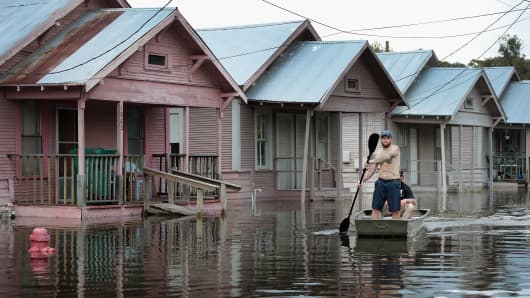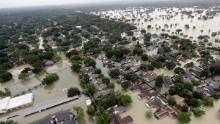Flooding of Texas Acid Pits
"Superfund sites are known to be the most dangerous places in the country, and they should have been properly protected against flooding."
Kara Cook-Schultz, TexPIRG
"Is he going to help? Can he help?"
"I lost my home. My job is gone. My tools are gone. My car is gone. My life is gone. What is Trump going to do?"
Devin Harris, 37, construction worker, Houston, Texas
 |
Scott Olson | Getty Images
Marine veterans Rocky Damico with the
Wounded Veterans of Oklahoma searches for residents in need of help
after torrential rains pounded Southeast Texas following Hurricane and
Tropical Storm Harvey causing widespread flooding on September 2, 2017
in Orange, Texas.
|
In Houston, devastated by the 125 centimetres of rain it received over the past week, an estimated 100,000 houses were destroyed or damaged. The municipality is still struggling to shelter tens of thousands of displaced residents in local schools, government buildings and the like. And while the mayor of the fourth most populous city in the United States has already announced that his city is "open for business", there is other business that demands attention.
Houston, known as a centre of the American petrochemical industry, is also the site of over a dozen 'Superfund' sites. These are toxic-chemical storage sites that the Environmental Protection Agency (EPA) designates as among the most contaminated areas in the country, and many of them are under water, thanks to the flooding, leaving the risk that dangerous sediment is being stirred up.
Toxic sludge and sulphuric acid from oil and gas operations fills these areas. In the 1980s, an estimated 22,000 cubic yards of hazardous waste and soil was excavated from the acid pits, but they remain a potential threat to groundwater. People living in close proximity draw their water from wells which the EPA monitors.
 |
| Water from the Addicks Reservoir flows into neighbourhoods in Houston as floodwaters rise August 29, CNN |
Depending on the specific contaminants in the various Superfund sites which vary widely, along with their concentration, threats to human health and surrounding wildlife resulting from rising waters inundating those Orwellian-named sites differs. Still, a report issued by the EPA made specific mention of the risk inherent in floodwaters carrying and spreading toxic materials over a wider area.
Two dozen of those sites had been identified as particularly vulnerable to flooding and rising sea levels. Their vulnerability and the threat they pose to surrounding communities well recognized, but evidently no action taken to remove the contents and store them or dispose of them safely elsewhere.
The National Weather Services warned that the Neches River would crest at over 6.5 metres above flood stage, about 2.5 metres higher than its previous record, and would impact on the Bailey Waste Disposal site south of Beaumont.
Across the San Jacinto River from Houston in Crosby, two Superfund sites sit, adjacent a small working class neighbourhood, an area that was devastated by Hurricane Harvey's floods. One house remains from among the dozen nearby the acid pits. "You never know what happens with the pollution under the ground. It filters into the water system", observed Rafael Casas, a resident of the area in concern over his groundwater well.
Flooding, according to a security guard at another Superfund site off the Houston Ship channel in Deer Park, arrived further inland during the storm, the water since receding back into the bayou. Testing in the past has revealed the sediments in the bayou contain pesticides, toxic heavy metals and PCBs. Active petrochemical facilities surround the site, awaiting a plan for cleanup.
An EPA survey last year revealed that soil from the former waste pits contain dioxins and other long-lasting toxins with their links to birth defects and cancer. It has long been known that the Texas Superfund sites were prone to flooding. This, in a first-world country known to be environmentally active, the richest nation on Earth, oblivious to the vulnerability of its population, exposed through an unfettered and lauded free market system.
| At the Highlands Acid Pit on Thursday, August 31, 2017, the No Trespassing sign on the barbed-wire fence encircling the 3.3-acre Superfund site barely peeked above the churning flood water from the nearby San Jacinto River. AP |
Labels: Contamination, Flooding, Hurricane, Texas, United States
0 Comments:
Post a Comment
<< Home